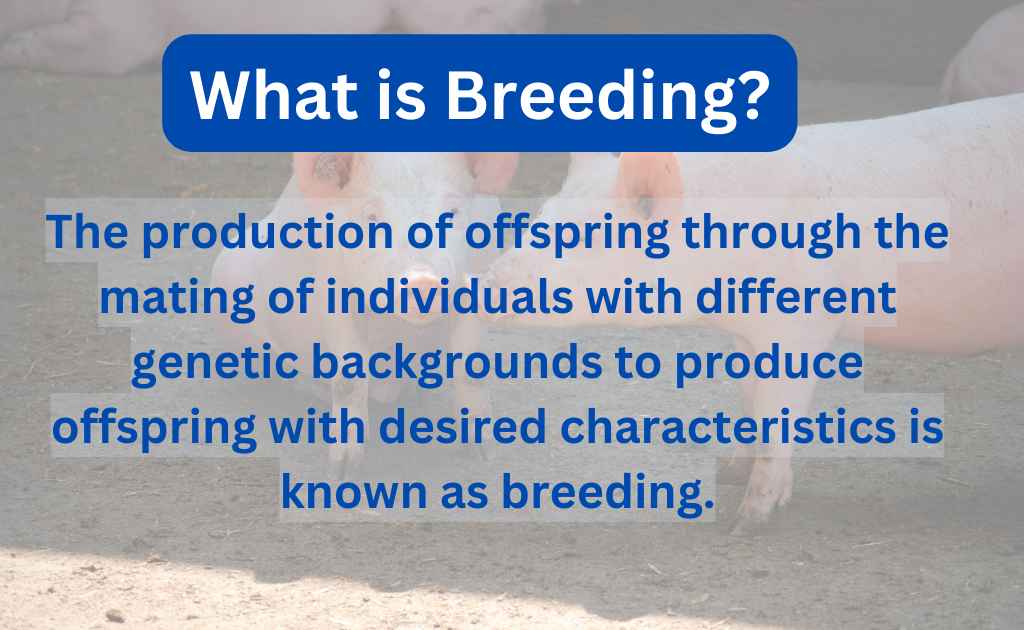What Is Breeding?-Definition, Principles, And Methods
Breeding refers to the process of producing offspring by mating individuals of different genetic backgrounds to produce offspring that have desired characteristics. This can be done through sexual reproduction, in which offspring are produced through the combination of genetic material from two parents, or through asexual reproduction, in which offspring are produced without the contribution of genetic material from a second parent.
Definition Of Breeding
The production of offspring through the mating of individuals with different genetic backgrounds to produce offspring with desired characteristics is known as breeding.

Key Points
- Breeding refers to producing offspring by mating individuals with different genetic backgrounds to produce offspring with desired characteristics
- Breeding can be natural or artificially through selective breeding or genetic engineering
- Principles of breeding include performance testing and EBVs, testing a large group of animals, proper management grouping, having a clear breeding objective, linking bulls or rams between seasons, comparing EBVs with breed average, increasing EBV accuracy through progeny data or pedigree and own performance data, and considering the heritability of a trait
- Methods of breeding include cross and selection, line breeding, hybrid breeding, cell and tissue culture, molecular markers, phenotyping, genetic engineering, genetic research, and genome editing
- Plant breeding methods include self-pollinated crops and cross-pollinated crops, with various methods for each type of crop
How Does Breeding Occur?
Breeding can occur naturally, through the process of natural selection, in which individuals with certain characteristics are more likely to survive and reproduce. It can also be done artificially, through human intervention, such as through selective breeding or genetic engineering.
Selective Breeding
Selective breeding is a type of artificial breeding in which humans intentionally mate individuals with desirable characteristics to produce offspring with those characteristics. This is often done in agriculture and animal husbandry to produce crops or animals with specific traits, such as higher yield, disease resistance, or improved meat quality.
Selective breeding is different from GMOs. Selective breeding shuffles existing genes, while GMOs directly edit the organism’s DNA. It allows for the introduction of entirely new traits.
Principles of Breeding
The following principles are to be followed to make successful breeding choices:
• Performance testing and EBVs can improve breeding accuracy
• Test a large group of animals, including those being culled, for the best results of breeding
• Proper management of grouping is important, and shorter breeding seasons can simplify testing and increase the accuracy of breeding
• Have a clear breeding objective and measure all relevant traits
• Linking between seasons and breeders can improve EBV accuracy
• Compare EBVs with the breed average to see if an organism is better or worse than the breed average
• Increase EBV accuracy by having more progeny data or using pedigree and own performance data
• Consider the heritability of a trait when selecting for it
Methods Of Breeding
There are several methods that can be used in plant breeding, including:
• Cross and selection: This involves crossing two plants with desirable traits and selecting the offspring with the desired characteristics.
• Line breeding: This involves selecting and reproducing plants with the desirable trait, and the best plants are crossed again.
• Hybrid breeding: This involves crossing two plants with different desirable traits to create a new plant with a combination of those traits.
• Cell and tissue culture: This involves growing plants from cells or tissue in a laboratory setting.
• Molecular markers: This involves using DNA markers to identify and select plants with desirable traits.
• Phenotyping: This involves evaluating the physical characteristics of plants to identify those with desirable traits.
• Genetic engineering: This involves manipulating the genetic makeup of plants through techniques like gene insertion or deletion.
• Genetic research: This involves studying the genetic makeup of plants to understand their characteristics and how they can be improved.
• Genome editing: This involves using tools like CRISPR to make precise changes to the genome of plants.
Plant Breeding Methods
Plant breeding is the process of improving plants for human use through genetic modification.
There are two main types of plant breeding methods:
1. Self-Pollinated Crops
2. Cross-Pollinated Crops
Self-Pollinated Crops
The following methods are used for plant breeding by using self-pollination:
• Mass selection: selecting plants with desirable characteristics and reproducing them
• Pure-line selection: selecting plants with a single desirable trait and reproducing them
• Pedigree selection: selecting plants based on their ancestry and reproducing them
• Bulk method: selecting plants based on their overall characteristics and reproducing them
• Backcross method: crossing a plant with its desired trait to a plant without the trait and reproducing the offspring with the desired trait
Cross-Pollinated Crops
The following methods are used for plant breeding by using cross-pollination:
• Mass selection: selecting plants with desirable characteristics and reproducing them
• Modified mass selection: selecting plants with a combination of desirable traits and reproducing them
• Recurrent selection: selecting plants with a single desirable trait and reproducing them over multiple generations
• Reciprocal recurrent selection: selecting plants with a single desirable trait and reproducing them over multiple generations with both male and female plants involved in the selection process.
Latest Research In Field of Breeding
Scientists are developing technologies to accelerate plant breeding and increase genetic diversity in breeding germplasm to improve food security and meet the challenge of global environmental change. [1]
Scientists use physiological breeding to combine complementary traits for higher yield, selecting progeny via remote sensing and genomic selection. This approach has shown success in Australia and developing countries, allowing for refined breeding methods and genetic gain. [2]
Tomato’s diploid nature and high haploid chromosome number make it an ideal plant for genetic and cytogenetic research. The interplay between genetics and breeding has contributed to progress in both fields. [3]



Leave a Reply